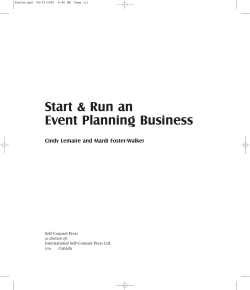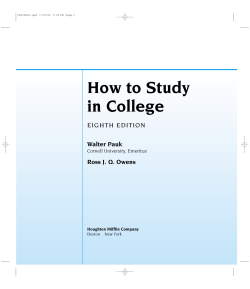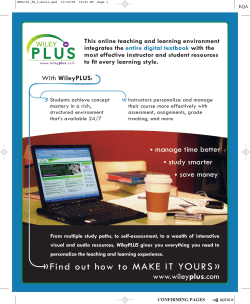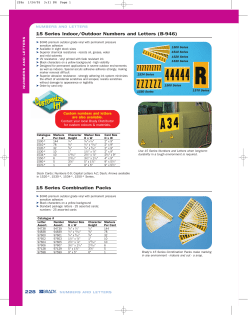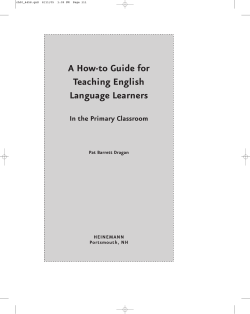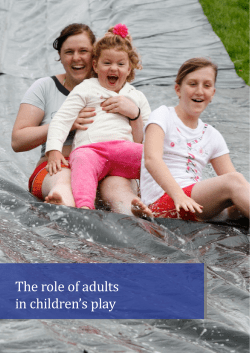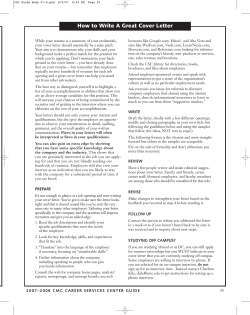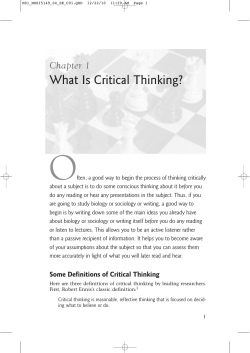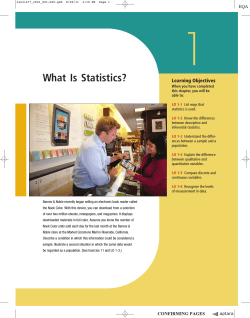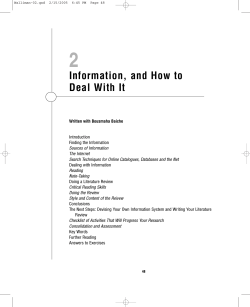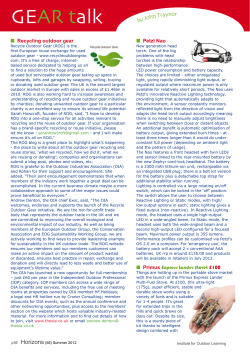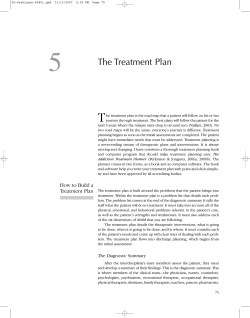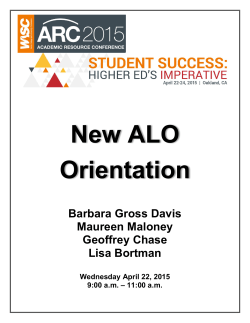
1 Children’s need for time and space to play
C01.QXD 16/1/07 3:13 pm Page 5 1 Children’s need for time and space to play Environments for play make up part of the landscape of childhood. Awareness of the local context and wider trends which impact on children’s lives help us to develop spaces that better meet their needs. In this chapter we will look at: Children’s need for time and space to play and specifically – drawing on one’s own resources – identity – connection to the community – social relations – contact with nature – physical activity. A spectrum of play types. Building up a picture of play opportunities in your area. There is no doubt that children’s access to space and time for play has dramatically altered over the latter part of the twentieth century and the beginning of the twenty-first. Many of the concerns that relate to environments for play are indicative of general global trends – a loss of space, the encroachment of adult management into children’s free time, fears about children’s use of outdoor space (because of traffic, ‘stranger danger’, bullying). Many of these changes give rise to serious concerns regarding the development of children and their immediate and long-term health, wellbeing and happiness. The well-documented 5 C01.QXD 16/1/07 3:13 pm Page 6 ENVIRONMENTS FOR OUTDOOR PLAY increase in childhood obesity and diabetes is noted not only in Hong Kong but also in the UK, in the USA and in Pacific countries. The negative results of inactivity and confinement to indoor spaces will have lifelong implications for those children. Loss of space for children’s play can be seen every time a playing field is sold off for development or when green space is lost to urbanisation. However, it is not just the physical loss of space that impacts on children. Children are excluded from more and more places for play and not just those (such as railway tracks) that are understandably forbidden. Increasingly rules and regulations bar children from playing in what were once public spaces (shopping centres and malls replace the public space of market squares and piazzas; theme parks replace public parks; school playgrounds fall under the ownership of management companies and are locked out of hours; young people are corralled into skate parks to avoid their public display). Public attitudes often seem to suggest that children’s play is a nuisance or even a criminal act and that a child playing outside without adult supervision is neglected, even if they are in the street around their home. These notions are sanctioned through the use of curfews and orders to disperse groups of young people in certain areas and in some countries. Children’s need for time and space to play The constraints and fears that limit children’s opportunities for play, particularly outdoors, deprive children of essential childhood experiences and opportunities – opportunities to develop friendships and negotiate relationships; opportunities to grapple with the full gamut of emotions including those such as jealousy, boredom or anger, as well as happiness and satisfaction; opportunities to take risks, have adventures and misadventures; to have contact with nature and the environment. It is because play offers unique benefits to children that the right to play is included in Article 31 of the UN Convention on the Rights of the Child which recognises: the right of the child to rest and leisure, and to engage in play and recreational activities appropriate to the age of the child and to participate freely in cultural life and the arts. (UNICEF, 1989) Drawing on one’s own resources In our hurried world, time for play as well as space to play can be in short supply for children whose schedules are as full as a chief executive’s. Individually, schools, childcare, after school activities and clubs have their own benefits, but do they leave enough time for the child to fall back on their own resources? Are children still having a chance to be bored, to hang about apparently aimlessly with friends, to be unsupervised? Is there time for a toddler to dawdle along picking up sticks? Or for an eight year old to mess about on the way home from school or for an adolescent to set aside their timetable and hang out with friends – or for any of us to take time to assimilate our experiences? If not, then an essential ingredient is missing. 6 C01.QXD 16/1/07 3:13 pm Page 7 CHILDREN’S NEED FOR TIME AND SPACE TO PLAY Sometimes making space for children’s play has less to do with the physical development of a site and more to do with releasing some time back into children’s control – whether that’s re-introducing ‘recess’ or ‘playtime’ back into the school day, disorganising the programme of a club, or parents taking the decision not to fill a child’s week with activity after activity. It is often adults rather than children who gain most from the planned programme of a club (which can act rather like a security blanket for us). We tend to worry about what would happen should our children become ‘out of control’ and can be somewhat uncertain as to what we should be doing if we are not occupying the children. And yet, replacing space for children’s own agency with adult agendas largely excludes spontaneity, imagination, unpredictability, flexibility – all the qualities we associate with free play. Creating time for children’s play allows them the opportunity to draw upon their own resources. Practitioners can support children’s view of themselves as people with a unique mix of skills, talents, capacities and potential. A full life needs us to respond to difficulties we encounter, to face up to conflicts, be flexible problem solvers, to recognise challenges and opportunities when we see them, to learn from difficult as well as pleasurable experiences and deal with disappointment. These experiences in self-directed play provide children with vital opportunities in the development of resilience. Identity For children to develop confidence and their own sense of identity it is essential that they go through these processes themselves – these cannot be replaced by adult-managed lessons. Children need opportunities to understand themselves as individuals and in relation to peers and their community. They discover their own preferences, choices and outlook on life, including an ethical outlook. They are striving for independence whilst also struggling with rejection or acceptance of aspects of culture and tradition around them. If a child’s identity is formed through a complex and fascinating alchemy of environmental adventures and genetic history, then the wider the range of environmental experiences on offer, the more opportunities there are for supporting each child’s developmental journey. (Zini, 2006: 29) Connection to the community We do not feel a strong sense of connection with the community unless we participate in it – and children’s play is one of their most fundamental ways of participating in community life. Children with disabilities are equally entitled. Their right to ‘fullest participation in the community’ is expressed in Article 23 of the UN Convention on the Rights of the Child. Article 23 recognizes that disabled children should ‘enjoy a full and decent life, in conditions that ensure dignity, promote self-reliance and facilitate the child’s active participation in the community’. (UNICEF, 1989) 7 C01.QXD 16/1/07 3:13 pm Page 8 ENVIRONMENTS FOR OUTDOOR PLAY Outdoor play environments are places where people of different backgrounds and ages can meet. They can provide a focus for community activity and promote social cohesion. Social relations We don’t really learn how social interaction works unless we ourselves have had the chance to make friends, to fall out, to try and get on with people we aren’t immediately drawn to, to sort out disagreements or experience the loss of a friendship. Environments for play have a crucial role in expanding the possibilities for play and therefore supporting children in this. Within play, rules of conduct, behaviour and interaction come from the children themselves and are negotiated and developed at their own initiative which means that the lessons they learn are particularly deep. What children learn in schools for example is not confined to the classroom. Captured lessons of the playground can include tolerance, the valuing of difference, and a respect for others, as well as current fads and fashions. Contact with nature You could read books about it or watch a video, but a sense of wonder and a connection with the planet we live on are better fostered by lying on the grass to look up at the sky, or by climbing to a hilltop, by skimming a stone on the waves or by letting an insect tickle the back of your hand. Firsthand encounters foster children’s sense of wonder with the natural world 8 C01.QXD 16/1/07 3:13 pm Page 9 CHILDREN’S NEED FOR TIME AND SPACE TO PLAY Many children’s experience of nature is second-hand and on a scale that can be difficult to grasp. Even those children who do not experience directly the power of the natural world are confronted with media images of disaster and destruction – earthquake, flood, tsunami. We teach them about climate change and how they must now be protected from the sun rather than enjoy it. Children can watch fantastic images of creatures in far away environments, sea creatures in the deepest part of the ocean, snow leopards on a remote mountain side, bats in subterranean caves, and yet they may not know the fascination of watching ants crossing a doorstep or birds feeding outside their window. The beginnings of a real connection are made at a more immediate and manageable level. Watching children on a beach or in garden we see how they can experience a space and make sense of it using their whole bodies and all their senses. Children benefit from frequently spending time in even a small outdoor space where they can encounter natural cycles, rhythms of life, growth and a rich sensory environment. The importance of the immediate environment to children is expressed in Hart (1997: 18): We should feed children’s natural desire to contact nature’s diversity with free access to an area of limited size over an extended period of time for it is only by intimately knowing the wonders of nature’s complexity in a particular place that one can fully appreciate the immense beauty of the planet as a whole. Physical activity The enormous health problems being stored up by children through poor diet and lack of physical activity are waking us up to the damage done to children if they do not have adequate opportunities for outdoor play. This has been shown by research (see for example Mackett, 2004) and it is obvious to most of us watching children at play that they can burn off a lot of calories doing so. Not all children are in to sport and not all of them like organised activities (and those who do probably don’t want them all the time), but all children do want to play. The beauty of play is that it gives children the chance to achieve the necessary levels of physical activity in a way that is motivated by the fun of it, that is different all the time and that develops a pattern of being active that will stay with a child because it is part of their daily life. Play environments can of course restrict or encourage opportunities for active play. ‘Keep off the grass’ and ‘No ball games’ rules will be rather de-motivating as will frankly boring areas, while areas with slopes and tunnels, things to jump off and through, exciting things to chase and interesting places to ‘hide and seek’ will be more energising. This does not mean that play spaces need to cater for physical activity through stereotypical equipment for running, jumping and climbing. Aiming for a space that supports the wide range of types of play will achieve the same end more successfully through, for example, wild group games of chase or fantasy and imaginative play with flying heroines and fleeing baddies. 9 C01.QXD 16/1/07 3:13 pm Page 10 ENVIRONMENTS FOR OUTDOOR PLAY A tall order? So play spaces have to be places where children can dawdle and daydream and also be motivated to shriek and run about! They are places for children to make contact with nature, with peers and with the community; places to take on risks and face challenges but also to maintain a sense of equilibrium. A tall order? Well, yes and no. Play is by its nature flexible, changeable and multi-faceted so an adequate environment for play is one that provides a platform from which play can take off. It doesn’t proscribe certain activities or feelings but does have hints and pathways, suggestions and possibilities. A spectrum of play types An issue that frequently emerges in play provision is that some types of play are given a higher value than others. This valuing leads to some types of play being praised and encouraged while others are actively discouraged or even forbidden, as shown in Figure 1.1. Many that are not highly valued by adults have enormous value to children and are understood very differently by children and adults. Not valued Accepted Highly valued Accepted Not valued Play on the spectrum may be perceived by adults as: aimless aggressive cooperative For example: rough and tumble day dreaming social play productive creative challenging art & music productions role play games dangerous disruptive deep play mimicry slang Fig. 1.1 A spectrum of play types and adult perceptions Source: Based on a model developed in the Play Inclusive (P.inc) Action Research Project by Theresa Casey and Susan McIntyre, 2005 Most highly valued are those types of play that are seen to be productive or potentially productive; play that is artistic, creative, musical, dramatic and that can produce products such as paintings or performances. Play which demonstrates positive values such as cooperation and negotiation is accepted, but play which is considered disruptive or which causes anxiety in adults is not valued and may be suppressed altogether. This can be play that appears aimless, challenging or aggressive. Playing in the rain, play fighting, play dealing with conflict or difficult issues such as death or gender roles, word play using slang, mimicry and in-jokes may all fall into these categories. 10 C01.QXD 16/1/07 3:13 pm Page 11 CHILDREN’S NEED FOR TIME AND SPACE TO PLAY Reflection on perceptions of play behaviour This activity is based on observation of children at play and reflection on adults’ responses to it. It can be based on a ‘real time’ observation but using a video recording may be more effective. (Ask permission first.) Make a video of a session or part of a session. Ask one or two people to watch it through, noting how adults respond to the children’s play and particularly which types of play are actively encouraged and discouraged. Bear in mind that encouraging or discouraging play can happen in a number of ways including how the space is set out, spoken words, body language, giving someone a ‘look’, imposing rules and so forth. If a video recorder is not available, or if you prefer, allocate one or two people as observers for a session.They can take notes of the types of play encouraged/discouraged and adult responses.They may also like to take photographs as visual prompts. Using the notes and/or the video, open a discussion with the team about the responses. Use specific examples from the observation. Use a flip chart to list on one side types of play encouraged and on the other those that were discouraged. Introduce the spectrum of play types (page 10). How does it compare to your lists? Questions to stimulate discussion might include: Is there a pattern to the responses made by adults? Why do we value some types of play over others? What concerns us about these and makes us want to halt them? What do children gain from each set? How can we find out from the children how they feel about different types of play? How do the children feel and react when we stop them? What could we do to widen the range of play opportunities available to the children? Involving children in the discussion You could ask children to act as observers and note takers as a way of feeding their views back into the discussion with adults. They may have an entirely different perspective. Ask them how they feel about adult interventions in their play. 11 C01.QXD 16/1/07 3:13 pm Page 12 ENVIRONMENTS FOR OUTDOOR PLAY The benefits of play come from children experiencing a wide range of play over time, at a level they choose at that time, rather than only a narrow band approved of by adults. Perceptions about what constitutes play will influence the type of play space developed. Where there is a perception of play as a very narrow band of behaviours then the play space may aim to cater only for that narrow band. A broad understanding of play and its benefits to children should result in a more all embracing vision. Building up a picture of play opportunities in your area This broader picture forms a backdrop to the development of specific, local spaces for play either through one-off developments or within a strategy for play, which should then be put into the context of the children’s lives. Even if you are intending to develop the established outdoor space of an existing setting (a nursery or out of school club for example) and feel you know the children and the community well enough already, it really is important to get some broad understanding of play locally to inform your thinking. For example, your setting is a nursery in an area in which families feel there is limited outdoor space that is safe for small children to play in. This impacts on the way children play and behave when they come in to your setting. They are only with you for a small number of hours in a week so perhaps also addressing the local play issues will give most support to the children. This means thinking about the environment for play solidly in the context of children’s day-to-day lives (and being sensitive to cultural and gender differences), for example by asking how the experiences available in your service will relate to and perhaps compensate for: the effects of local community dynamics; the breadth of experiences in the children’s everyday play; their use of the immediate environment; their amount of free-time and how they are expected to use it. Building a picture of play in the community or area you are concerned with is a vital exercise when considering the development of existing (or the creation of new) play space. It will: begin the process of engaging both children and community members; help you understand the current use of space and local dynamics; help you to identify what is most required and why; provide evidence that can be used when seeking wider support and funds for your eventual plan. 12 16/1/07 3:13 pm Page 13 CHILDREN’S NEED FOR TIME AND SPACE TO PLAY It is most likely that a number of methods will be necessary to create a full picture. The number and choice of methods would depend on the scale of the project and local circumstances. Building a picture of the play in the area – a selection of methods to try out Carry out a mapping exercise with the children of their local area to find out where they play, what kind of spaces they do or don’t like to play in and why, and what stops children from playing in the places they would like to. Bring together children in small groups and physically walk the area together and discuss it as you go. Make sure all the points that are made are noted: a dictaphone is useful to capture the colour of what is said and children can take photos to match up with key points, or draw, write or use symbols to add detail to a map. It can be very interesting to find how these places connect and how children travel between them. (Some of the most interesting play ‘spaces’ are actually journeys between points.) Enlarge a map of the area on a photocopier. The children can draw and write directly on it. Again, capturing the discussion on tape or video is always useful as not everything gets written down. Give children their own cameras or video recorders to make short photodocumentaries of their area. Many children have access to cameras on mobile phones or digital cameras. Use these to download play images to a computer. Take a walk around the area and look out for the places children play. Try this at different times of day, different days of the week and, if time allows, at different times of the year. Remember that play changes with the seasons and the weather; use that to prompt memories of play experiences. There may also be local traditions, festivals and events that are part of the play calendar. Try making a play calendar. On a long strip of paper mark out in sections the months of the year or the seasons. Leave plenty of space in each. Children and adults can mark (writing, drawing or using symbols) the kind of things that they do at different points in the year. Encourage them to put in what they actually do (or for adults what they also did as children) and not just stereotypes such as bonfires in autumn or sledging in winter if that isn’t actually the case. Any of these can be displayed locally – school, library, community centre, a friendly shop – with simple questionnaires or more maps for people to pick up, complete and return. ▼ C01.QXD 13 C01.QXD 16/1/07 3:13 pm Page 14 ENVIRONMENTS FOR OUTDOOR PLAY You could try asking the local newspaper to print a request for memories and memorabilia of play in the area. They might print one of your blank maps and ask readers to return it. Offer a prize as an incentive. Make up a questionnaire and distribute it locally to find out views about play spaces. Tailor it to children or adults but you can ask the same kind of questions. Form the questions carefully though – make sure they are understandable and stick to the main points you are trying to find out about. If possible involve the children in drafting, testing and finalising the questionnaire. Children and community members can also be involved in compiling and reviewing returns. Some notes on seeking children’s views Remember that children will have a range of very different experiences of local spaces. A child who uses a wheelchair, for example, may not currently be able to access all the spaces other children tell you about. A child with a visual impairment might have preferences for different reasons from their peers. Some areas are very territorial so children may feel with these that they are confined within defined boundaries. Children of different ages want different things from a play space in terms of levels of challenge, types of play, support and privacy. All of these viewpoints, and others, are valid and should be sought to build up a rich picture. The onus is on you to ensure children have a fair chance to contribute their views. You might make an effort to go to particular places to seek children’s views – the local special school or unit, a refugee support project, a homeless unit or individual families, for example – and to ensure that the methods you use are appropriate to the needs of the particular children. It would be ill-advised to just go out and speak to groups of children in the community whom you do not know – it may well be misconstrued and you will be unprotected. If you want to do some fieldwork make sure you are backed up by a proper framework, which could include: – a fully written plan; – accurate recordkeeping; – collaboration with local agencies who are known and trusted in the area; – carrying identification; – working in pairs or teams and not alone; – informing local organisations and interested parties (parents, the local police, the community council and school perhaps) about what you intend to do and when. 14 C01.QXD 16/1/07 3:13 pm Page 15 CHILDREN’S NEED FOR TIME AND SPACE TO PLAY Bear in mind that when children tell you where they like to play this requires trust. They won’t tell you about exciting, forbidden places if they think you are going to tell them off, report them, or worse start to invade their space. You will need to establish ground-rules to begin with and inform them that although you will respect what they tell you, if they do tell you something that you think means that they are at risk of harm you will have to do something about it. Make sure you have their permission before videoing or photographing them. You might risk loosing some information or participants but it is better than loosing their trust before you have even started. (See Further reading at the end of this chapter for more on seeking children’s views.) All of this information gathering will help to create a picture of the local play scene and will be invaluable in identifying the next steps forward. Hold on to all the documentation you have acquired. What the information gathering might suggest Not all the issues that arise will necessary point to the development of a new or specific space for play. Introducing traffic calming measures or excluding cars from certain areas will be a good way of enabling children to play outside safely if danger from traffic is the main concern. Bringing in playworkers to facilitate play in the local streets or park where children are perceived to be ‘hanging about’ will reduce the likelihood of children being viewed with suspicion or fear. If children are worried about bullying or parents are concerned about ‘stranger danger’, a regular adult presence (community members or paid staff) at a play area will be reassuring. Contacting the cleansing or maintenance departments of the local authority or organising a neighbourhood clean-up project may help to make play spaces more accessible if another worry is litter and broken glass. Contacting the local paper about the state of the play space can also be a good tactic if you need to apply some pressure to get things moving. Arranging for playworkers to bring interesting play resources on a regular basis to the local fixed play area can help to make it more inclusive of disabled children if they feel excluded. Bringing together people with responsibility or interest in developing opportunities for play is one way to find out what resources and support they can offer (see also Chapter 6). 15 C01.QXD 16/1/07 3:13 pm Page 16 ENVIRONMENTS FOR OUTDOOR PLAY SUMMING UP There is growing recognition that reliance on fixed equipment playgrounds as we have come to know them does not adequately meet children’s play needs and so this is a time when we need to revisit classic ideas (such as adventure playgrounds, urban farms and children’s gardens) or look at alternative ways to provide space or environments for play (public space, mobile play provision, street play, for example). The play that occurs in a specific setting should be seen in the context of children’s lives and their general access to opportunities for play. Designing play spaces should take that into account. For children to really gain all the benefit that they might out of the play environments we create with them, they should reflect and embrace a sense of play as being broad, rich and unpredictable. Further reading Alderson, P. and Morow, U. (2004) Ethics, Social Research and Consulting with Children and Young People. Ilford: Barnardo’s. Murray, P. (2002) Disabled Teenagers’ Experiences of Access to Inclusive Leisure. York: Joseph Rowntree Foundation. (Available at: www.jrf.org.uk) 16
© Copyright 2025


